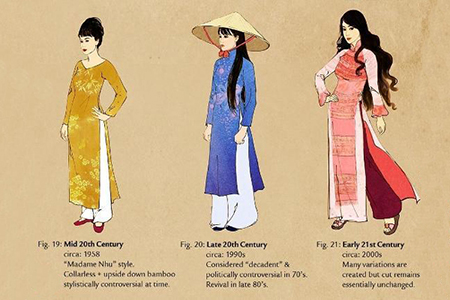Women wore the traditional Vietnamese tunic when they were not working in the fields. Urban women wore the garment for festive or solemn occasions or when they went to the pagoda. The traditional tunic differs from one region to another.
The north of Vietnam (Bac Bo) and Central Vietnam (Trung Bo) have many tunics, including an unbuttoned one with two front flaps of equal length that hang freely and one with front flaps tied together and worn over a bodice that covers the neck for modesty's sake. A five-piece unbuttoned tunic has an outer, larger flap on the left side that is twice as broad as the inner flap on the right; a belt keeps the flaps from hanging too low.

The four-flapped tunic was very popular in Kinh Bac, a region of traditional culture north of the Red River and including Bac Ninh Province and part of Bac Giang Province. This tunic, often worn over two others, is called the "three-piece dress;" women wear its third part made of gauze when going on pilgrimages in the spring. The gauze outer tunic is black or brown or dark violet; the two inner tunics are ivory, lotus-pink, yellow or sky-blue. The collar is round; the flap, straight; and the sleeves, tight. The tunic is buttoned from the waist up to under the arm, but from there to the neck, it is left unbuttoned; the collar is turned down to show a part of the coloured inner tunics.
When the Nguyen lords settled in Central Vietnam in the 17th century, this tunic was influenced by the long dresses of the Cham culture. Because of this influence, the four- flapped tunic became the ao dai.



